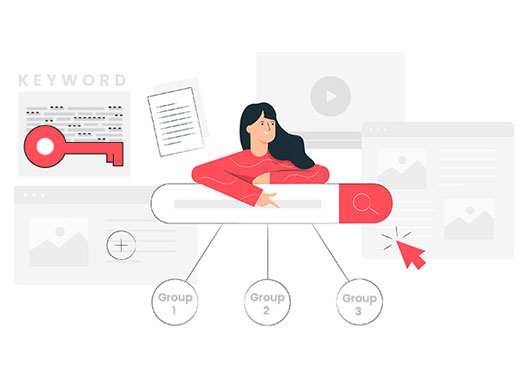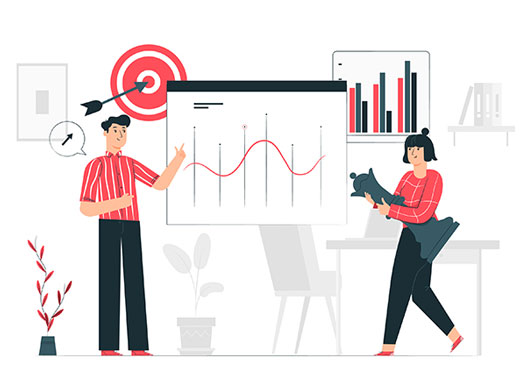Strategic Spending in Retail: How to Allocate Your Marketing Budget
Contributors:
Amol Ghemud
Published: March 14, 2024

Imagine this: you’re a retail captain at the helm of a treasure ship, overflowing with unique products. But here’s the catch – your navigational tools are a bit wonky. Allocating your marketing budget without a strategic plan is akin to sailing the high seas with a faulty compass. You might stumble upon some success, but chances are, you’ll end up lost in a sea of missed opportunities and dwindling resources.
Here’s the good news: crafting a treasure map, in this case, your marketing strategy, is entirely achievable. By strategically allocating your budget, you can steer your retail ship towards a prosperous horizon.
However, navigating this financial terrain comes with its own set of challenges. Think of it like trying to decipher an ancient riddle – how much do you invest in each marketing channel? Should you prioritise social media buzz or focus on building brand loyalty? Without a clear plan, you risk overspending on ineffective tactics, leaving your marketing efforts adrift.
Setting SMART Goals
Before diving into specific channels and tactics, having a clear destination in mind is paramount. This is where SMART goals come into play. Think of them as your North Star, guiding your budgetary decisions and ensuring your marketing efforts are laser-focused.
SMART stands for:
- Specific: Clearly define what you want to achieve. Don’t just aim for a “general increase in brand awareness.” Instead, strive for a target like “achieve a 20% boost in website traffic from social media referrals within the next quarter.”
- Measurable: Quantify your goals. How will you gauge success? Track website traffic, conversion rates, or social media engagement metrics to measure progress.
- Achievable: Be ambitious, but realistic. Don’t set goals that are completely out of reach.
- Relevant: Ensure your goals align with your overall business objectives. Is increasing brand awareness your primary focus, or are you aiming to drive immediate sales?
- Time-bound: Set a specific timeframe for achieving your goals. This creates a sense of urgency and helps you track progress effectively.
Illustration: SMART Goals in Action
Let’s see how SMART goals translate into the real world of retail marketing:
- Goal: Increase customer loyalty by 15% within the next 6 months.
- Strategy: Implement a targeted email marketing campaign offering exclusive discounts and personalised product recommendations to existing customers.
- Goal: Generate 100 new qualified leads through social media advertising by the end of the quarter.
- Strategy: Develop engaging content tailored to your target audience’s interests and utilise social media advertising platforms to reach a wider demographic.
By setting SMART goals, you lay the groundwork for a targeted and effective marketing strategy, ensuring your budget is invested in initiatives with a clear path towards achieving desired outcomes.
Understanding Your Audience
Imagine trying to have a conversation with a complete stranger. It would be challenging to tailor your message to their interests, wouldn’t it? The same principle applies to marketing. Without a deep understanding of your target audience, your marketing efforts become akin to shouting in a crowded room – you might get some attention, but it’s unlikely to resonate with the right people.
This is where the concept of a customer persona comes into play. Think of it as a detailed profile of your ideal customer, encompassing their:
- Demographics: Age, gender, income level, location, etc.
- Behaviour: Shopping habits, online activity, preferred communication channels.
- Preferences: Interests, values, pain points, and buying triggers.
By understanding these aspects, you can:
- Craft targeted messaging: Tailor your communication to resonate with your audience’s specific needs and desires.
- Select the most effective marketing channels: Allocate your budget towards channels frequented by your target audience.
- Personalise the customer experience: Develop marketing campaigns that feel relevant and engaging to your ideal customer.
So, how do you unlock the secrets of your customer persona?
Here are a few key methods:
- Market research: Conduct surveys, focus groups, or analyse customer data to gather insights into their demographics, behaviour, and preferences.
- Social media listening: Monitor online conversations to understand the language your target audience uses, the topics they discuss, and the challenges they face.
- Customer relationship management (CRM) data: Analyze past purchases and interactions to glean valuable insights into customer behaviour and preferences.
By leveraging these tools, you can paint a clear picture of your ideal customer, enabling you to make informed decisions about budget allocation.
Optimising Your Marketing Arsenal
In today’s dynamic retail landscape, a multi-channel marketing approach is no longer a luxury, it’s a necessity. Imagine having an entire arsenal of tools at your disposal, each with unique strengths:
- Social media: Connect with your audience on platforms like Facebook, Instagram, or TikTok to build brand awareness, share engaging content, and foster community interaction. Strength: High reach and potential for viral engagement. Weakness: Short attention spans and ever-changing algorithms can limit organic reach.
- Email marketing: Cultivate relationships with your customers through targeted email campaigns offering personalised recommendations, exclusive discounts, and valuable content. Strength: Strong ROI potential and allows for direct communication with a permission-based audience. Weakness: Inbox clutter can lead to low open rates.
- Influencer marketing: Partner with social media personalities or industry experts who resonate with your target audience to leverage their credibility and reach. Strength: Builds trust and authenticity through word-of-mouth marketing. Weakness: Finding the right influencer with genuine alignment to your brand can be challenging.
- Content marketing: Establish yourself as a thought leader by creating informative and engaging content (e.g., blog posts, videos, infographics) that addresses your audience’s pain points and interests. Strength: Builds brand loyalty and trust by providing valuable information. Weakness: Requires consistent content creation and effective distribution strategies.
The key to optimising your marketing channels lies in understanding the strengths and weaknesses of each, and then allocating your budget accordingly. By analysing data such as website traffic, conversion rates, and social media engagement, you can track the ROI (Return on Investment) of each channel and identify which ones are driving the most sales and brand engagement.
This data-driven approach ensures you’re not just throwing money at the wall, but strategically investing in channels that demonstrably yield results. Remember, your marketing budget is a precious resource, and allocating it wisely is the cornerstone of achieving sustainable growth in the competitive world of retail.
Data-Driven Decisions
Imagine navigating at night solely by the stars. While impressive, it wouldn’t be the most efficient course of action. In today’s data-driven world, relying solely on intuition for budget allocation is akin to sailing in the dark. Data analytics empowers you to make informed decisions and optimise your marketing spend.
Why Data Matters:
- Data-driven insights reveal valuable customer behaviour patterns, exposing which channels resonate most effectively and where to focus your resources.
- Metrics like website traffic, conversion rates, and customer engagement paint a clear picture of campaign performance, allowing you to identify areas for improvement.
- Data analysis empowers you to measure ROI (Return on Investment) precisely, enabling you to make adjustments and maximise the return on your marketing budget.
Key Metrics to Monitor:
- Website Traffic: Tracks the total number of visitors to your website. Analyse traffic sources (organic search, social media referrals, etc.) to understand which channels drive the most visitors.
- Conversion Rates: Measures the percentage of visitors who take a desired action (e.g., make a purchase, sign up for an email list). High conversion rates indicate effective marketing efforts.
- Customer Engagement: Tracks metrics like social media engagement (likes, comments, shares), email open rates, and click-through rates. High engagement indicates that your audience is resonating with your content.
Harnessing the Power of Data Tools:
A plethora of data analytics tools are available to help you gain insights from your marketing efforts. Popular options include:
- Google Analytics: A free tool that provides comprehensive website traffic data and audience insights.
- Social media analytics tools: Built-in analytics dashboards offered by major social media platforms provide valuable data on audience demographics, engagement metrics, and campaign performance.
- Marketing automation platforms: These platforms offer features for tracking customer behaviour across various channels and measuring campaign effectiveness.
A/B Testing Explained
Imagine having two different sail designs – wouldn’t it be helpful to test which one propels your ship faster? A/B testing offers a similar advantage in the world of marketing.
A/B testing involves presenting two variations of a marketing element (e.g., email subject line, website call-to-action button) to different audience segments. By analysing the results, you can determine which variation performs better.
A/B Testing in Action:
Let’s say you’re running an email marketing campaign promoting a new product line. You can:
- Test Subject Line A: “Introducing our latest collection!”
- Test Subject Line B: “Limited-time offer: Up to 50% off new arrivals!”
By monitoring which email subject line yields a higher open rate, you gain valuable insights into your audience’s preferences and can optimise future campaigns for better results.
By embracing a data-driven approach and incorporating A/B testing into your marketing strategy, you continuously refine your course, ensuring your budget is invested in initiatives that deliver the highest impact. In the final section of this blog, we’ll explore additional tips to maximise the effectiveness of your marketing spend.
Experimentation is Key
Imagine a skilled sailor who rigidly adheres to a single course regardless of wind changes or unforeseen obstacles. Similarly, a successful marketing strategy requires a willingness to experiment and adapt.
The Power of Experimentation:
- Market dynamics are constantly evolving. Customer preferences, competitor strategies, and even the broader economic landscape can shift unexpectedly.
- Trying new things allows you to discover hidden gems. A seemingly unconventional marketing tactic might yield surprisingly positive results.
- A/B testing is just one form of experimentation. Be open to exploring new channels, content formats, and even partnerships to discover what resonates most effectively with your audience.
Building for the Future: Long-Term Vision
While short-term sales goals are crucial, a successful retail strategy extends beyond immediate transactions.
- Invest in brand building: Craft a compelling brand narrative that resonates with your target audience and fosters long-term loyalty.
- Content marketing plays a vital role here. By consistently creating informative and engaging content, you establish your brand as a thought leader and build trust with potential customers.
- Customer relationship management (CRM): Implement strategies to nurture relationships with existing customers. Loyalty programs and personalised communication go a long way in retaining customers and driving repeat business.
Conclusion
In conclusion, navigating the retail landscape requires a strategic approach to marketing budget allocation. By:
- Setting SMART goals to ensure your efforts are targeted and measurable.
- Understanding your customer persona to tailor your marketing messages to the right audience.
- Optimising your marketing channel mix by leveraging data and A/B testing to identify the most effective avenues to reach your target market.
- Embracing experimentation to stay ahead of the curve and discover new opportunities.
- Maintaining a long-term vision to build brand loyalty and foster sustainable growth.
You can transform your marketing efforts from a scattered voyage into a well-charted course towards achieving your retail business goals.
Our website is brimming with valuable tools and resources. Dive deeper, explore content marketing strategies, and stay updated on the latest marketing trends. By continuously learning and refining your approach, you can ensure your marketing budget propels your retail business towards continued success.
FAQs
1. What are SMART goals, and how can they help me allocate my marketing budget effectively?
SMART goals are Specific, Measurable, Achievable, Relevant, and Time-bound. They help you define clear objectives for your marketing campaigns and ensure your budget is directed towards achieving those goals.
For example, instead of a vague goal of “increasing brand awareness,” a SMART goal could be “achieve a 20% boost in website traffic from social media referrals within the next quarter.” This specific and measurable target allows you to track progress and allocate your marketing budget towards channels most likely to drive social media traffic.
2. How can I understand my target audience better?
Understanding your target audience, also known as your customer persona, is crucial for crafting effective marketing messages and allocating your budget efficiently. Here are some methods to gain insights:
- Market research: Conduct surveys, focus groups, or analyse customer data to gather demographic information, behavioural patterns, and preferences.
- Social media listening: Monitor online conversations to understand the language your audience uses, the topics they discuss, and the challenges they face.
- Customer relationship management (CRM) data: Analyze past purchases and interactions to glean valuable insights into customer behaviour and preferences.
By understanding your ideal customer’s demographics, behaviour, and preferences, you can tailor your marketing messages and choose channels they frequent, ensuring your budget is spent on initiatives that resonate with your target audience.
What are some key metrics to track the effectiveness of my marketing campaigns?
Data analysis is essential for measuring the success of your marketing efforts and optimising your budget allocation. Here are some key metrics to track:
- Website Traffic: Tracks the total number of visitors to your website. Analyse traffic sources (organic search, social media referrals, etc.) to understand which channels drive the most visitors.
- Conversion Rates: Measures the percentage of visitors who take a desired action (e.g., make a purchase, sign up for an email list). High conversion rates indicate effective marketing efforts.
- Customer Engagement: Tracks metrics like social media engagement (likes, comments, shares), email open rates, and click-through rates. High engagement indicates that your audience is resonating with your content.
By monitoring these metrics and employing tools like Google Analytics and social media analytics dashboards, you can measure the ROI (Return on Investment) of each marketing channel and identify which ones are delivering the most value for your budget.
Read More:
How Much Should Fintechs Spend on Marketing: Budget Allocation
Driving Brand Awareness: Budgeting for Marketing in the FMCG Sector
The Ultimate Ecommerce Marketing Pricing Guide
Strategic Spending in Healthcare Marketing: Where to Allocate Your Budget
How Much Does Edtech Marketing Cost: How Much to Spend (Without Breaking the Bank)
About the Author
Optimizer in Chief
Amol has helped catalyse business growth with his strategic & data-driven methodologies. With a decade of experience in the field of marketing, he has donned multiple hats, from channel optimization, data analytics and creative brand positioning to growth engineering and sales.
 Growth Strategy and Planning
Growth Strategy and Planning Inbound Growth
Inbound Growth Growth Hacking
Growth Hacking Search Engine Optimization
Search Engine Optimization Paid and Performance Marketing
Paid and Performance Marketing Social Media Marketing
Social Media Marketing AI-Driven Growth Strategy
AI-Driven Growth Strategy
 Growth Tools
Growth Tools Offers
Offers






















Leave a Reply